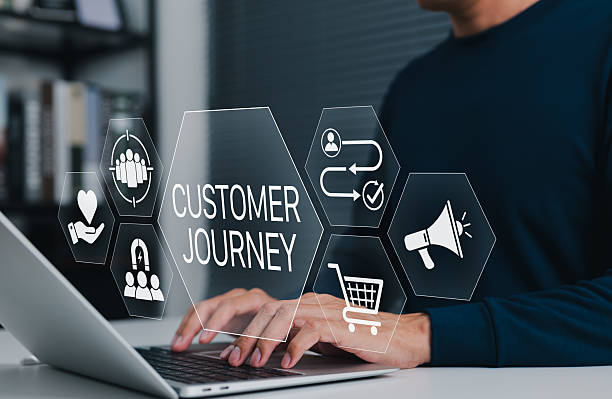Customer Journey Funnel: Aligning Stages With Marketing Goals
In the dynamic landscape of modern marketing, the customer journey funnel remains a foundational framework for guiding prospects from initial curiosity to loyal advocacy. This model, often visualized as a narrowing pathway, captures the progression through distinct stages: awareness, consideration, conversion, loyalty, and advocacy. Yet, its true power emerges not in isolation but through deliberate alignment with overarching marketing objectives. By synchronizing each stage with targeted goals—such as brand visibility, lead nurturing, or revenue growth—organizations can optimize resource allocation, enhance customer experiences, and drive sustainable results. This strategic integration transforms the funnel from a static diagram into a living blueprint for business success.
Decoding the Funnel’s Core Stages
At its essence, the customer journey funnel delineates how individuals interact with a brand over time, influenced by touchpoints across digital and traditional channels. Far from a linear descent, contemporary funnels account for loops, exits, and re-entries, reflecting the non-linear behaviors of today’s empowered consumers. To align effectively, marketers must first dissect these stages with precision, identifying pain points and opportunities unique to their audience.
Consider the awareness stage, where potential customers first encounter the brand. Here, the influx is broad and exploratory, driven by search queries, social media scrolls, or content recommendations. Marketing goals at this juncture typically revolve around visibility and education—establishing the brand as a credible authority without immediate sales pressure. Tactics might include SEO-optimized blog posts or targeted ad campaigns that highlight problem-solving insights rather than product pitches.
Transitioning into the consideration stage, interest sharpens as prospects evaluate options. This phase demands deeper engagement, where goals shift toward building trust and differentiation. Interactive tools like webinars or personalized email sequences can illuminate value propositions, helping customers weigh alternatives against the brand’s offerings.
The conversion stage marks the pivotal commitment, whether through a purchase, sign-up, or subscription. Alignment here focuses on frictionless execution, with goals centered on maximizing close rates. Streamlined checkout processes, urgency-driven promotions, and retargeting ads serve as catalysts to propel hesitant visitors across the threshold.
Post-conversion, the loyalty stage sustains momentum, aiming to convert one-time buyers into repeat patrons. Goals emphasize retention and satisfaction, often through loyalty programs or exclusive content that reinforces ongoing value.
Finally, the advocacy stage extends the funnel’s reach, where delighted customers become amplifiers. Marketing objectives here prioritize amplification, leveraging testimonials and referral incentives to harness organic growth.
Each stage, while interconnected, requires tailored strategies to prevent leakage and ensure seamless progression.
Strategic Mapping: Linking Stages to Measurable Objectives
Alignment begins with a rigorous mapping exercise, where marketing goals are not generic aspirations but stage-specific benchmarks tied to broader business imperatives. For instance, if revenue expansion is the north star, awareness efforts might target a 20% uplift in organic traffic, while conversion goals could aim for a 15% improvement in cart completion rates. This granular approach demands cross-functional collaboration—sales insights informing consideration tactics, customer service data shaping loyalty initiatives.
In practice, misalignment often stems from siloed thinking. A common pitfall is overloading the awareness stage with hard-sell messaging, alienating newcomers before they reach consideration. Instead, strategic alignment advocates for a “goals cascade”: top-level objectives (e.g., market share growth) filter down to stage-level KPIs, ensuring every campaign contributes cohesively. Tools like customer relationship management (CRM) systems facilitate this by tracking progression metrics, revealing drop-off patterns that signal misaligned efforts.
To illustrate, envision a B2B software firm seeking to penetrate a competitive sector. At awareness, the goal aligns with thought leadership—producing whitepapers that address industry pain points, measured by download volumes and initial site visits. Consideration then pivots to qualification, using gated content and nurture campaigns to score leads based on engagement depth. Conversion goals tighten around demo scheduling, with A/B-tested landing pages optimizing for appointment bookings. Loyalty extends via onboarding resources and quarterly check-ins, targeting net promoter scores above 70. Advocacy closes the loop with co-created case studies, incentivizing referrals that feed back into awareness.
This mapping isn’t static; it evolves with market shifts, requiring periodic audits to recalibrate goals against performance data.
Tactical Levers for Enhanced Alignment
Implementing alignment demands a blend of creativity and discipline, leveraging tactical levers that resonate across stages without diluting focus. Content marketing emerges as a versatile anchor: at awareness, evergreen guides build topical authority; in consideration, comparative analyses highlight unique strengths; during conversion, urgency-laden ebooks seal decisions.
Personalization amplifies these efforts, using data signals to tailor experiences. For loyalty, segment-specific recommendations—drawing from past behaviors—foster a sense of bespoke care, aligning with goals of reduced churn. Advocacy benefits from user-generated content prompts, turning satisfied customers into brand evangelists through shareable success stories.
Technology plays a pivotal role, yet it must serve strategy, not supplant it. Automation platforms can orchestrate multi-stage journeys, triggering consideration emails upon awareness interactions or loyalty offers post-conversion. However, over-reliance on tech risks impersonal scaling; the advisory path forward involves human oversight to infuse empathy, ensuring goals like customer-centric growth remain paramount.
Budget allocation further underscores alignment. Progressive distribution—70% to awareness and consideration for long-term pipeline health, 20% to conversion for immediate wins, and 10% to loyalty and advocacy for compounding returns—prevents resource starvation in critical phases. Regular ROI assessments refine this, reallocating based on stage-specific attribution models.
Challenges arise, particularly in fragmented ecosystems where privacy regulations constrain data flows. Strategic alignment counters this by prioritizing first-party insights and zero-party data collection, such as preference quizzes at awareness, to fuel personalized goals without invasive tracking.
Navigating Common Pitfalls in Funnel Optimization
Even with robust mapping, pitfalls lurk, threatening alignment’s efficacy. One prevalent issue is stage compression, where aggressive conversion tactics encroach on consideration, eroding trust. The remedy lies in pacing: allowing sufficient dwell time at each juncture, guided by behavioral analytics that flag premature pushes.
Another hurdle is goal ambiguity, where vague targets like “increase engagement” lack quantifiable anchors. Advisory best practices call for SMART criteria—specific, measurable, achievable, relevant, time-bound—to sharpen focus. For advocacy, this might translate to “secure 50 ambassador referrals quarterly,” directly tying to acquisition cost reductions.
External volatilities, from economic downturns to algorithmic changes, can disrupt flows. Resilient alignment incorporates scenario planning: stress-testing goals against disruptions, with contingency tactics like pivoting loyalty perks to cost-effective virtual events during budget squeezes.
Moreover, overlooking the human element undermines progress. Customers aren’t data points; they’re navigating complex lives. Aligning stages with empathetic goals—such as inclusive messaging in awareness to broaden appeal—builds authentic connections, elevating beyond transactional exchanges.
Cultivating a Culture of Continuous Refinement
True mastery of funnel alignment transcends one-off initiatives, embedding a culture of perpetual refinement. This entails fostering agile teams that iterate based on real-time feedback loops, from customer surveys at loyalty to A/B variants across stages. Leadership commitment is crucial, modeling goal-oriented decision-making that permeates the organization.
Training programs equip teams with funnel fluency, teaching how micro-actions ripple through stages. For example, a sales rep’s consideration dialogue can preview loyalty benefits, pre-aligning conversion goals with retention aspirations.
Metrics dashboards provide visibility, blending quantitative (e.g., stage velocity) with qualitative (e.g., sentiment analysis) indicators. Quarterly reviews dissect variances, celebrating wins like a 25% advocacy uplift while dissecting shortfalls, such as consideration drop-offs from outdated content.
In this vein, alignment becomes a strategic compass, steering marketing from reactive firefighting to proactive orchestration. By viewing the funnel as an ecosystem of interdependent goals, brands not only capture value at each stage but amplify it exponentially.
Envisioning Tomorrow’s Aligned Journeys
As digital frontiers expand—think AI-driven hyper-personalization or metaverse touchpoints—the imperative for alignment intensifies. Forward-thinking marketers will embed adaptability into their funnels, anticipating emergent stages like “exploration” in immersive environments. Goals will evolve accordingly: awareness via virtual demos, consideration through AI-simulated trials, conversion with blockchain-secured transactions.
Ethical considerations loom large, with alignment extending to responsible practices—transparent data use, inclusive representation—that safeguard trust across stages. This holistic stance positions brands as stewards of the journey, not mere participants.
Ultimately, aligning the customer journey funnel with marketing goals isn’t a destination but a disciplined pursuit. It demands vigilance, innovation, and an unwavering customer lens. Those who master this symphony will not only fill their pipelines but cultivate ecosystems where loyalty and advocacy flourish naturally, propelling enduring prosperity.




